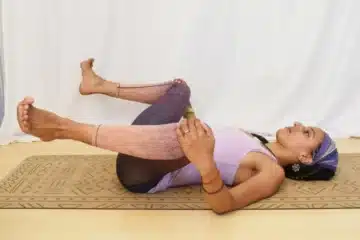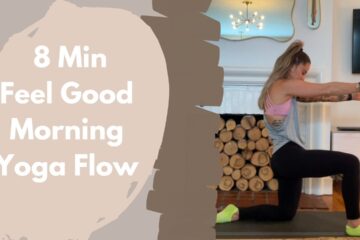In the fast-paced world we live in, finding moments of stillness and relaxation can be challenging, especially when dealing with back pain.
However, yin yoga offers a gentle and therapeutic approach to relieving back pain by targeting the deeper connective tissues of the body, promoting flexibility, and fostering a sense of calm and ease.
In this article, we’ll explore the principles of yin yoga and how it can be a powerful tool for alleviating back pain and promoting overall well-being.
Understanding Yin Yoga
Yin yoga is a slow-paced, meditative style of yoga that focuses on passive, long-held poses designed to target the deeper layers of connective tissue, such as ligaments, tendons, and fascia.
Unlike more dynamic styles of yoga that emphasize muscular strength and endurance, yin yoga encourages practitioners to relax into poses, allowing gravity to gently stretch and release tension in the body.
The practice of yin yoga is based on the principles of Chinese Taoist philosophy, which views the body as a network of energetic channels or meridians through which life force or chi flows.
By holding poses for an extended period—typically three to five minutes or longer—yin yoga aims to stimulate and balance the flow of chi, promoting physical, mental, and emotional well-being.
Benefits of Yin Yoga for Back Pain Relief
Yin yoga offers a multitude of benefits for individuals dealing with back pain, including:
- Increased Flexibility: Yin yoga poses gently stretch and lengthen the muscles and connective tissues of the spine, promoting greater flexibility and range of motion. By releasing tension and tightness in the back muscles, yin yoga helps alleviate stiffness and discomfort associated with back pain.
- Improved Joint Health: Holding yin yoga poses for an extended period allows the joints of the spine to decompress and hydrate, reducing pressure and promoting lubrication. This can help alleviate symptoms of conditions such as degenerative disc disease and spinal arthritis, which contribute to back pain.
- Stress Reduction: The slow, meditative nature of yin yoga encourages deep relaxation and stress reduction, triggering the parasympathetic nervous system’s “rest and digest” response. By promoting relaxation and calm, yin yoga helps reduce muscle tension and alleviate psychological stressors that contribute to back pain.
- Enhanced Body Awareness: Yin yoga cultivates mindfulness and body awareness, encouraging practitioners to tune into subtle sensations and cues within their bodies. By developing a greater sense of proprioception, individuals can identify areas of tension or imbalance in the back and respond with gentle, targeted stretches and breathwork.
- Supportive Environment for Healing: Yin yoga provides a supportive environment for healing and self-exploration, allowing practitioners to connect with their bodies on a deeper level and cultivate a sense of compassion and acceptance. By creating space for stillness and introspection, yin yoga promotes emotional resilience and facilitates the release of stored tension and trauma in the body.
Yin Yoga Poses for Back Pain Relief: Here are some yin yoga poses that target the back and can help alleviate discomfort and tension:
- Sphinx Pose:
- Lie on your belly with legs extended behind you and elbows directly under your shoulders.
- Press into your forearms and lift your chest and head, keeping the hips grounded.
- Hold for 3-5 minutes, focusing on lengthening the spine and opening the front of the chest.
- Seal Pose:
- From Sphinx Pose, straighten your arms and lift your chest and head even higher, coming into a deeper backbend.
- Keep the elbows slightly bent and the shoulders relaxed away from the ears.
- Hold for 3-5 minutes, breathing deeply into the chest and upper back.
- Caterpillar Pose:
- Sit on the floor with legs extended in front of you and feet hip-width apart.
- Fold forward from the hips, reaching your hands towards your feet or the floor.
- Allow your spine to round naturally and relax your head and neck.
- Hold for 3-5 minutes, surrendering to gravity and releasing tension in the spine and hamstrings.
- Supported Fish Pose:
- Place a bolster or folded blanket lengthwise on your mat.
- Sit in front of the bolster with knees bent and feet flat on the floor.
- Lie back over the bolster, allowing it to support your spine and head.
- Relax your arms by your sides or extend them overhead.
- Hold for 3-5 minutes, feeling a gentle opening in the chest and upper back.
- Thread the Needle Pose:
- Begin on your hands and knees in Tabletop position.
- Reach your right arm underneath your body, threading it between your left hand and left knee.
- Lower your right shoulder and temple to the mat, feeling a stretch in the right side of the upper back.
- Hold for 3-5 minutes, then switch sides.
Incorporating Yin Yoga into Your Back Pain Relief Routine
To experience the full benefits of yin yoga for back pain relief, consider incorporating the following practices into your routine:
- Start Slowly: If you’re new to yin yoga or dealing with severe back pain, start with shorter holds (1-2 minutes) and gradually increase the duration as your body adapts.
- Listen to Your Body: Pay attention to how your body responds to each pose and adjust as needed to find a comfortable edge. Avoid pushing into pain or discomfort and prioritize relaxation and surrender.
- Use Props: Props such as bolsters, blankets, and blocks can provide additional support and comfort in yin yoga poses, allowing you to relax more deeply and release tension.
- Practice Mindful Breathing: Incorporate deep, diaphragmatic breathing into your yin yoga practice to enhance relaxation and promote deeper release in the muscles and connective tissues of the back.
- Be Patient and Persistent: Healing takes time, so be patient with yourself and trust in the process. Consistent practice and gentle persistence will gradually yield improvements in flexibility, mobility, and overall well-being.
Conclusion
Yin yoga offers a gentle and therapeutic approach to relieving back pain by targeting the deeper layers of connective tissue, promoting flexibility, and fostering relaxation and calm.
By incorporating yin yoga into your back pain relief routine and exploring gentle, long-held poses, you can create space for healing, release tension, and cultivate a greater sense of ease and well-being in your body and mind.
Embrace the transformative power of stillness and discover the profound healing potential within the practice of yin yoga.


